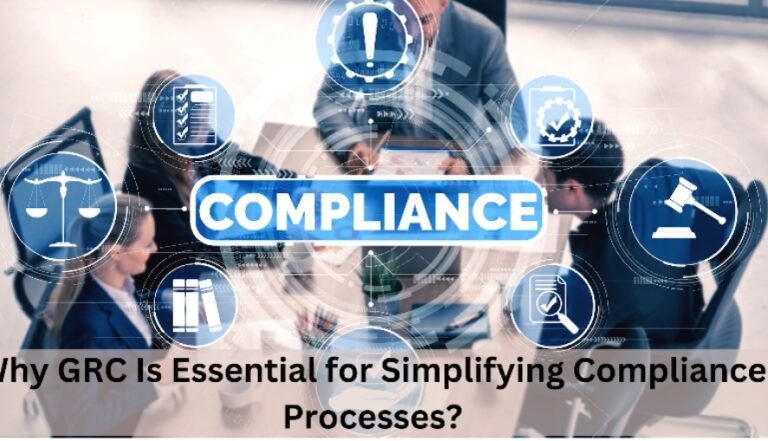How can businesses keep up with the ever-growing complexity of regulatory compliance? As the landscape of rules, standards, and laws becomes more intricate, traditional methods of managing compliance are no longer effective.
This is where Governance, Risk, and Compliance (GRC) solutions come in. These tools simplify compliance processes, enhance risk management, and improve organizational efficiency. In this blog, we will explore how adopting GRC solutions can help businesses navigate regulatory challenges and ensure long-term success.
Why GRC Compliance Is More Than a Framework
Governance, Risk, and Compliance (GRC) are integrated approaches to managing corporate risks, regulatory requirements, and internal controls. It goes beyond a basic compliance framework by aligning business strategies with regulatory demands. This strategic integration ensures that businesses are not only compliant but also prepared for future challenges.
GRC compliance solutions help organizations stay ahead of evolving regulations by streamlining efforts and reducing the risk of costly mistakes. As a result, companies can maintain smooth operations while meeting the demands of regulators and stakeholders alike.
How GRC Solutions Simplify Compliance Processes for Businesses
Tracking compliance manually is difficult, prone to errors, and time-consuming. GRC application software can automate all these activities and offer real-time monitoring and compliance for businesses. It also cuts down the workload for compliance teams and boosts their accuracy by reducing human errors. The processes make them faster, helping businesses respond to compliance updates more quickly.
Automated systems also offer better scalability, allowing the organization to handle increased compliance requirements with less effort. Businesses turn to grc compliance software to tackle these challenges. These tools streamline compliance workflows by automating repetitive tasks and centralizing data, ensuring businesses stay aligned with evolving regulations and reducing the risk of non-compliance.
How GRC Solutions Simplify Compliance:
Most GRC solutions automatically handle data collection, compliance checks, and reporting. These processes tend to be faster and more reliable for end-users. These solutions also integrate with other business systems, offering companies a unified platform to manage compliance.
In addition, they provide real-time updates, ensuring that any latest information about compliance changes does not slip by. GRC software centralizes information and therefore pulls all departments involved in the same effort operating their activities with the same information.
They may also be customized in such a way as to suit the needs of any company in particular, thus making certain that it solves any unique specific compliance challenges.
Risk Management in GRC
Risk management is a crucial component of any GRC framework. With the right tools, businesses can spot risks early, assess their impact, and take action to prevent them from becoming compliance issues. GRC tools help businesses identify potential threats and take swift action to address them before they cause harm.
They also enable businesses to continuously monitor risk factors, detecting new or evolving risks immediately. Moreover, GRC frameworks help foster a culture of proactive risk management, where identifying and mitigating risks becomes part of daily operations.
Risk management in GRC tools helps businesses by:
- Automating Risk Detection: GRC tools scan for risks, helping businesses detect issues faster.
- Prioritizing Risks: Once risks are found, GRC software helps rank them by their impact, focusing attention on the most critical threats first.
- Mitigation Strategies: These tools also help create strategies to reduce the chances of compliance problems, making it easier to manage risks effectively.
- Continuous Monitoring: GRC tools provide ongoing monitoring, so businesses stay aware of emerging risks.
- Improved Decision-Making: By providing a clear view of risks and their potential impact, GRC tools enable better, data-driven decision-making.
Benefits of Integrating GRC Software for Businesses
These long-term benefits include both lowering costs in operations and higher efficiency. Organizations have reported significant reductions in risk-related costs, plus improved decision-making as a consequence of integrating GRC tools into systems.
Key Benefits of Integrating GRC Solutions:
Integrating GRC solutions into business operations brings numerous benefits, including the most significant: real-time compliance tracking that keeps organizations aware of their compliance status and aligned with evolving regulations.
GRC frameworks also promise scalability, allowing an organization to grow when the business expands so that compliance activities can be carried out without additional resource burdens placed on existing teams.
Automating compliance tasks reduces manual effort, which leads to massive savings over time, adding to efficiencies. Data-driven decisions are supported by integrated GRC systems that provide deep insights, allowing organizations to fuel long-term success and growth.
Why GRC Frameworks Are Crucial for Modern Businesses
As businesses navigate increasingly complex regulatory environments, having a strong GRC framework becomes essential for maintaining compliance. With the right system in place, organizations can quickly adjust to changes in laws and regulations without needing to completely overhaul their processes.
A solid GRC framework ensures that businesses stay on top of compliance requirements, safeguarding their legal, financial, and reputational standing. It also allows businesses to respond more effectively to regulatory changes, helping them avoid costly penalties and legal issues.
GRC Frameworks Are Key To:
GRC frameworks are customizable to meet the unique needs of various industries, regions, and business models. This flexibility ensures that businesses can tailor compliance processes to their specific requirements.
With a robust GRC framework, organizations are better positioned to handle the dynamic challenges of a constantly changing regulatory environment. By implementing such frameworks, businesses can secure their long-term success and minimize the risks associated with non-compliance.
How GRC Can Simplify Regulatory Compliance Processes
GRC frameworks simplify regulatory compliance by combining key functions like legal, IT, and risk management into a single system. This integration reduces the complexity of compliance tasks, allowing businesses to focus more on growth and strategic priorities.
With GRC systems in place, companies can avoid getting bogged down by constant compliance issues and instead dedicate more time to advancing their goals.
Key Simplification Factors:
One of the main advantages of GRC frameworks is the centralization of data. By bringing all compliance data into one system, businesses can easily track progress and generate reports.
A unified approach, which includes the collaboration of legal, IT, and risk management teams, ensures that all departments work together in a consistent way to meet compliance goals. This cohesion helps streamline processes and reduce errors, making compliance management more efficient.
Comparison Table: Benefits of GRC Solutions vs. Traditional Compliance Methods
| Feature | GRC Solutions | Traditional Methods |
| Automation | Automates tasks like tracking and reporting. | Manual processes are prone to errors. |
| Real-time Updates | Immediate updates to compliance standards. | Updates may be delayed. |
| Risk Management | Proactively identifies and mitigates risks. | Reactive, often after a risk has occurred. |
| Data Centralization | Consolidates all compliance data in one platform. | Data is fragmented across multiple systems. |
| Scalability | Scales with business growth. | Difficult to scale without significant changes. |
How GRC Automation Improves Compliance Management
- Automation simplifies routine compliance tasks, reducing staff workload and minimizing errors.
- Automated compliance tracking, auditing, and reporting save businesses time and effort.
- Faster response times to regulatory changes help businesses stay ahead and avoid non-compliance risks.
- Automation improves efficiency, ensuring quicker adaptation to evolving regulations.
Conclusion
A GRC solution is indeed what every business is to add up to its solution basket, and that solution solves compliance processes, brings forth improved risk handling, and also contributes to overall operational efficiency, making it a significant tool for any modern organization.
A GRC solution will help business organizations automate repetitive processes, centralize their data, and offer real-time insights. Such an investment would be geared towards creating not only a well-established GRC framework for reducing risks but also for ensuring business continuity and sustainability in the future.
FAQs
Why is GRC so important?
GRC is essential for enabling organizations to manage their risks as well as comply with regulations all while improving the quality of decision-making that drives business success.
What is the role of GRC in Governance, Risk, and Compliance?
GRC integrates governance, risk management, and compliance efforts, ensuring alignment of business objectives with regulatory requirements, which achieves reduced risks and guarantees compliance.
What are the benefits of GRC implementation?
GRC implementation simplifies the compliance process, increases the efficacy of risk management, bolsters operational efficiency, and cuts expenses due to non-compliance.
Passionate content writer and savvy blog publisher, Aamir crafts compelling stories and insightful articles that captivate and inform. With a knack for blending creativity and strategy, they bring fresh perspectives to every piece. Dive into their world of words and discover content that resonates.





